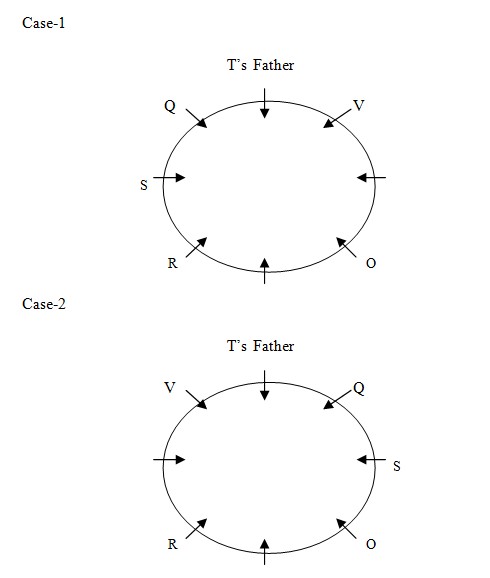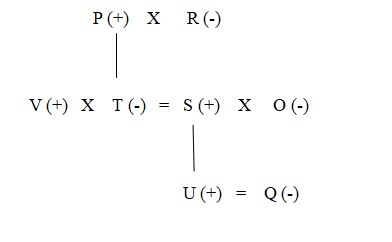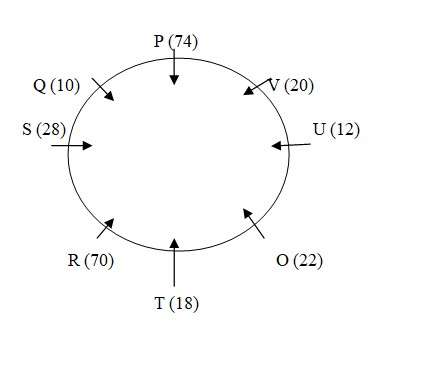Question
Who among the following sits fourth to the right of
P? Study the following information carefully and answer the question below- There is a family of eight people O, P, Q, R, S, T, U and V and are sitting around a circular table facing to the centre. There are three married couples in the family. They are from three generations. None of the member of the third generation is married. They are of different age but their ages are in descending order according to their generation such as Grandfather is the eldest, grandmother is the second eldest, son is the third eldest, daughter- in – law is the fourth eldest, son – in – law is the fifth eldest, daughter is the sixth eldest, grandson is the seventh eldest and granddaughter is the eighth eldest. The person who sits immediate right of V is a male but he is not U. S who is sitting next to Q is not sitting opposite to O. Only the father of T is sitting between Q and V. Q is the female member of the family. V’s age is 2 year less than O’s age and O’s age is 6 year less than S’s age. U’s age is multiple of 4 but not a perfect square. R is the mother of S and her age is 2.5 of the age of her son. R is 4 year younger than P. The age of the second eldest person is 70 year. V is the brother – in – law of O. P does not sit opposite to the second youngest person. T does not belong to third generation. T has no child. The person who is sitting on the immediate left of O and immediate right of R is 18 years old while Q is 10 year old.Solution
The age of the second eldest person is 70 year which means the age of the grandmother is 70 year. V is the brother – in- law of O. V’s age is 2 year less than O’s age and O’s age is 6 year less than S’s age. R is the mother of S and her age is 2.5 of the age of her son. From these it is clear that O, V and S belongs to second generation and R is the grandmother whose age is 70 year. Further, only the father of T is sitting between Q and V. T does not belong to third generation. So, T belongs to second generation. The person who is sitting on the immediate left of O and immediate right of R is 18 year old while Q is 10 year old. S, who is sitting next to Q, is not sitting opposite to O.  Q is the female member of the family. Q is 10 year old. So, Q is the granddaughter and 10 year old. R is 4 year younger than P. Means P is 74 year old. Rest U’s age is multiple of 4 but not a perfect square. As only remaining position is that U is the grandson and is 12 year old. The person who sits immediate right of V is a male but he is not U. So, from this case 3 will be eliminated. As we know that U can’t sit between R and O, so clearly T sit between R and O and U can’t sit to immediate right of Q so from this case 2 will be eliminated. Rest we know that the age of T is 18 year so she is the daughter of P and S is the son of R and is 28 year old. Rest V is 20 year old, O is 22 year old, O is 22 year old. So, the final arrangement is –
Q is the female member of the family. Q is 10 year old. So, Q is the granddaughter and 10 year old. R is 4 year younger than P. Means P is 74 year old. Rest U’s age is multiple of 4 but not a perfect square. As only remaining position is that U is the grandson and is 12 year old. The person who sits immediate right of V is a male but he is not U. So, from this case 3 will be eliminated. As we know that U can’t sit between R and O, so clearly T sit between R and O and U can’t sit to immediate right of Q so from this case 2 will be eliminated. Rest we know that the age of T is 18 year so she is the daughter of P and S is the son of R and is 28 year old. Rest V is 20 year old, O is 22 year old, O is 22 year old. So, the final arrangement is – 

L, M, N, O and P are five buses of different sizes. Two of them provide food on board, 3 are luxurious buses and 3 are air conditioned buses. One has ca...
Which diagram correctly represents the relationship of pigeons, birds, dogs?
There are 5 books A, B, C, D & E placed on table. If A is placed below E, C is placed above D, B is placed below A and D is placed above E, then which ...
If 'green' means 'yellow', 'yellow' means 'white', 'white' means 'red', 'red' means 'violet', 'violet' means 'black'; then which of the following will b...
Statements:
Amit is a good fielder.
All fielders have big hands.
Conclusions:
I. All people with big hands are fielder...
X says, "Y” is my mother's only daughter." How Is Y related to X?
Read the given statements and conclusions carefully. Assuming that the information given in the statements is true, even if it appears to be at variance...
Select the term that is related to the third term in the same way as the second term is related to the first term.
Cheerful : Morose : : Valiant :?
A run walks 5 m south from his office, turns left and walks 3m, again turns left and walks 13 m, then turns left and walks 3 m to reach the grocery shop...
In a certain code language. 'COCK' is written as 'EQEM', and 'DUCK' is written as 'FWEM'. How will 'SWAN' be written in that language?


